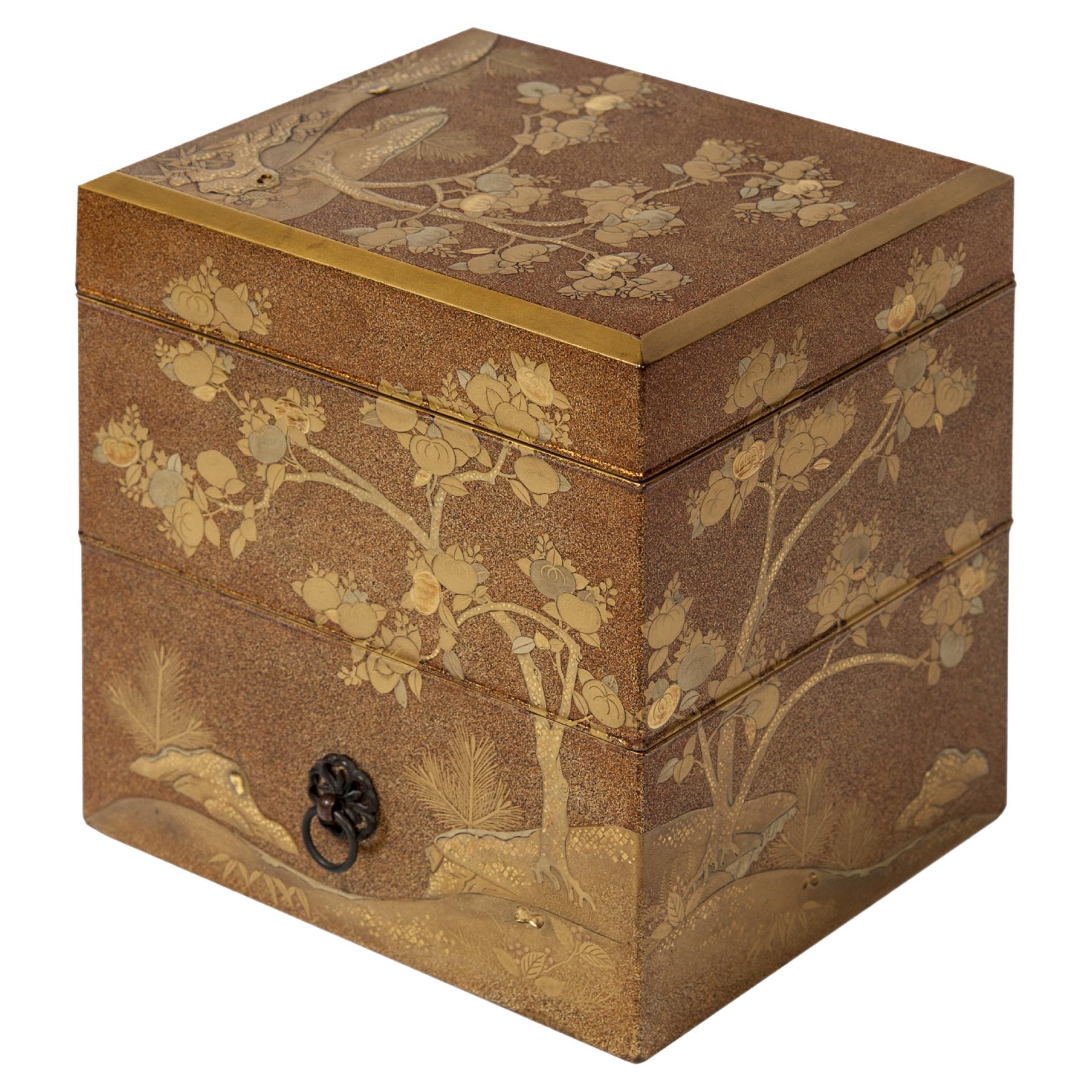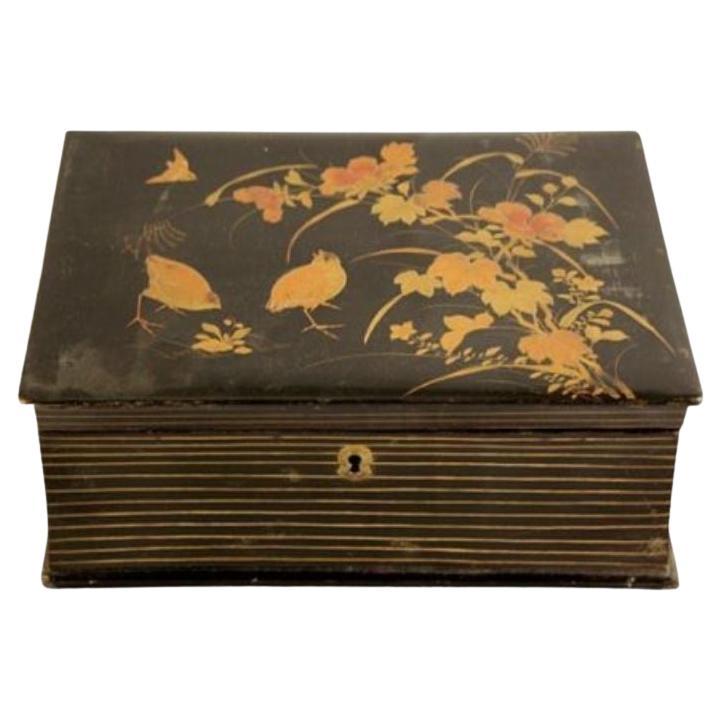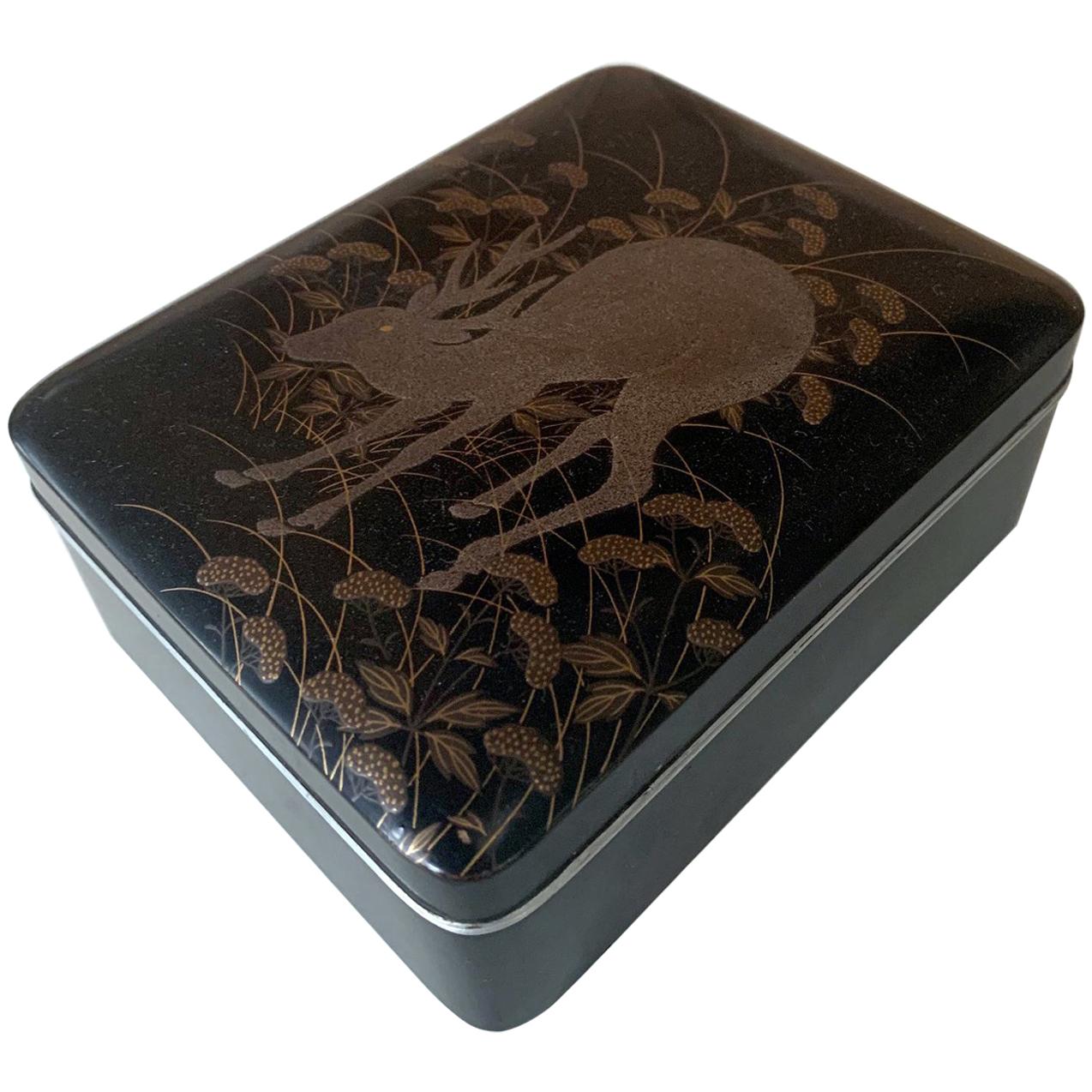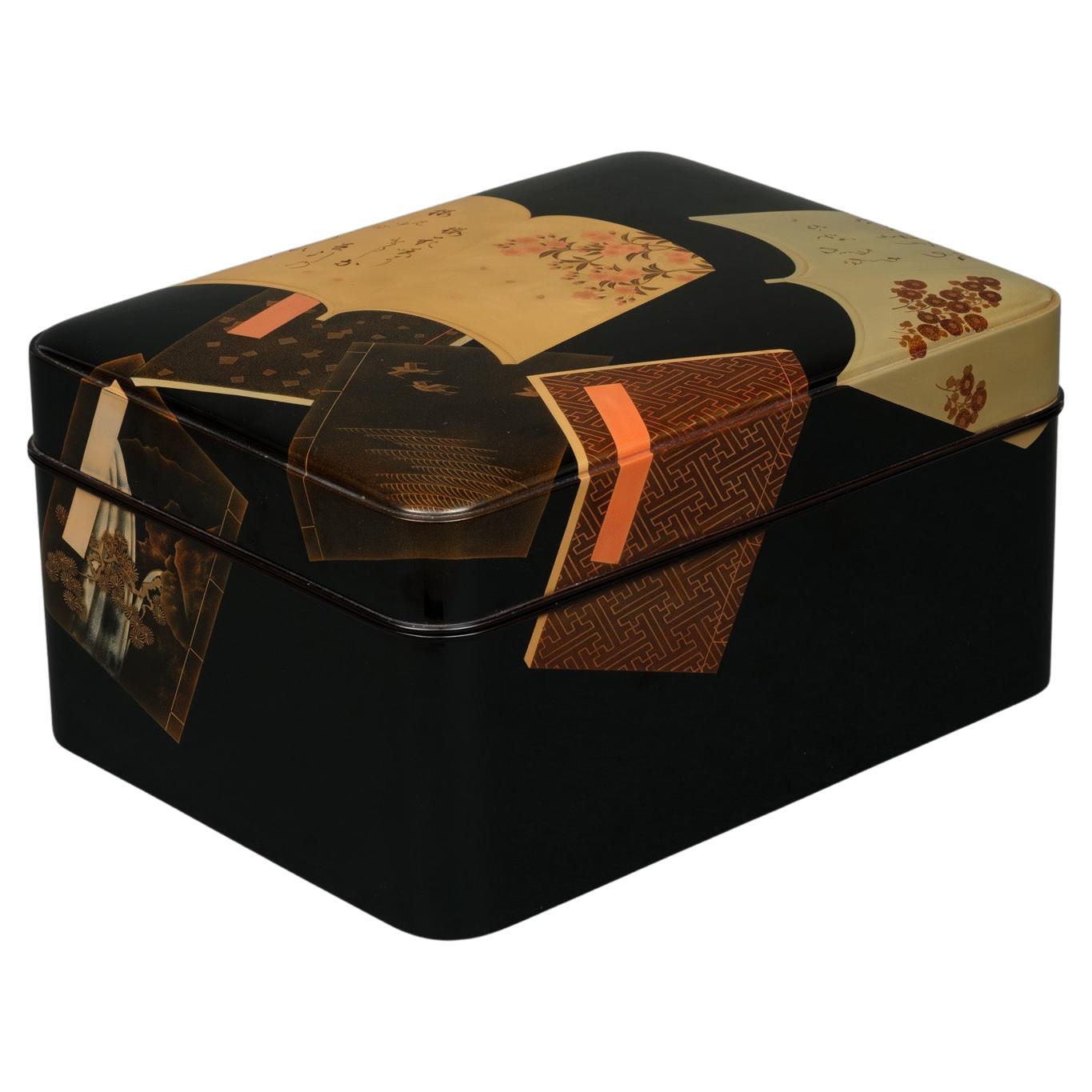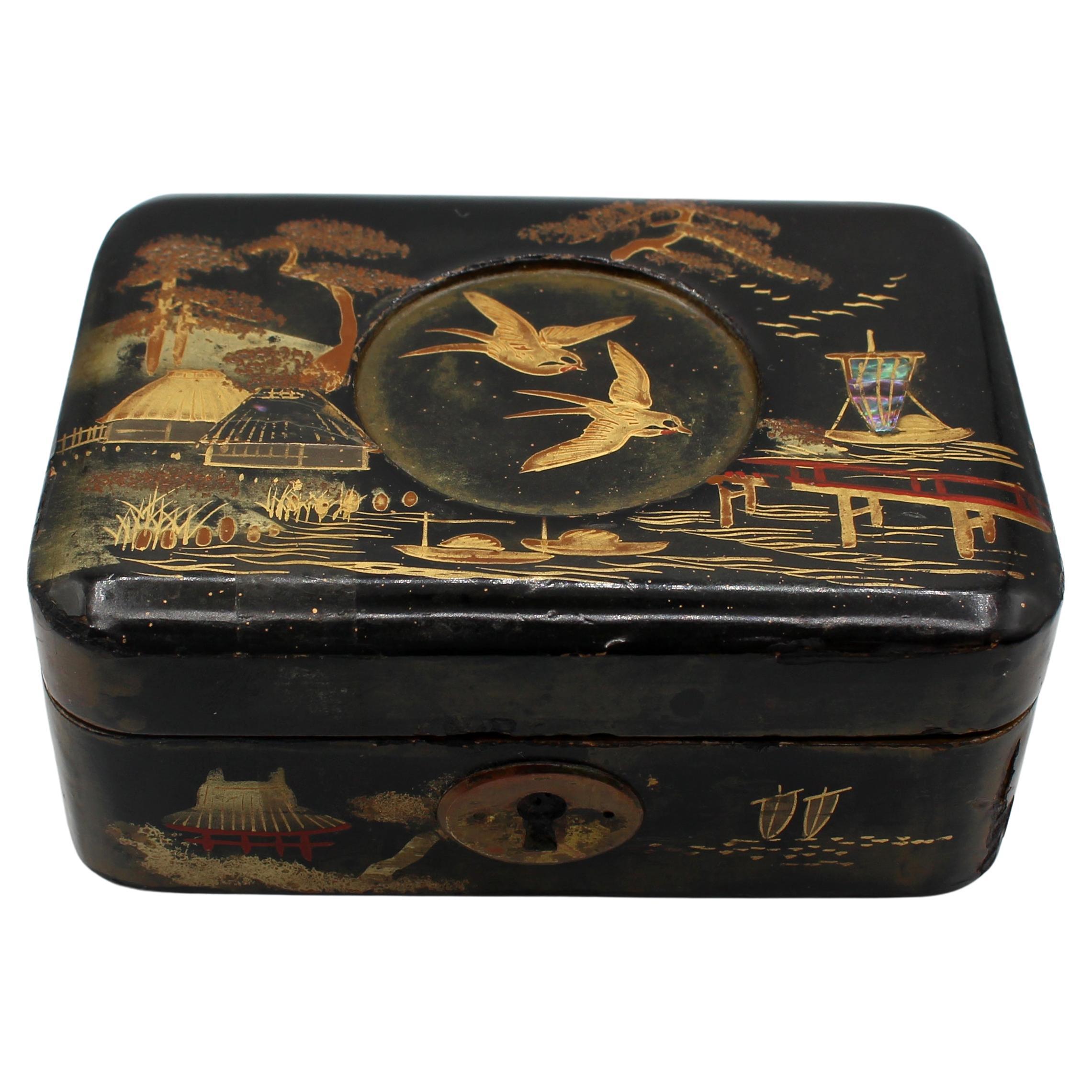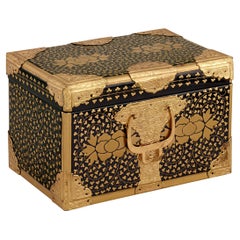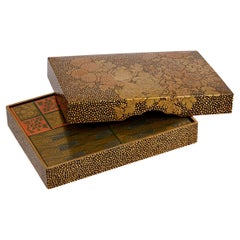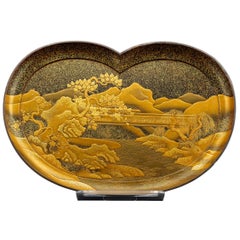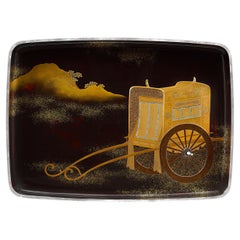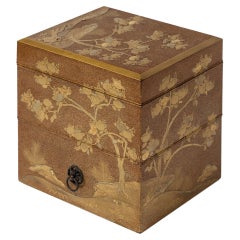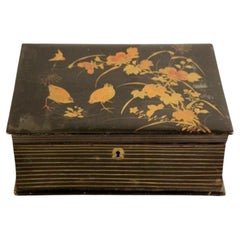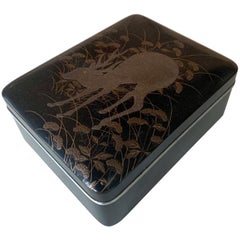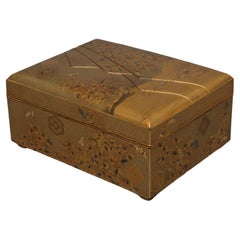Items Similar to Japanese Lacquer Box
Want more images or videos?
Request additional images or videos from the seller
1 of 7
Japanese Lacquer Box
$39,850
£30,253.44
€34,603.48
CA$55,676.23
A$61,924.12
CHF 32,334.85
MX$753,550.67
NOK 412,965.39
SEK 387,288.68
DKK 258,259.05
Shipping
Retrieving quote...The 1stDibs Promise:
Authenticity Guarantee,
Money-Back Guarantee,
24-Hour Cancellation
About the Item
This exquisite Meiji-period lacquer document box known as a ryoshibako showcases the meticulous artistry of maki-e, a technique of raised lacquer decoration. Adorned with gold and vibrant hues, it features emblems representing the four esteemed classes of Edo society: samurai and warriors, farmers, craftsmen and merchants. Each class is symbolized through intricately rendered designs, including a bow on a stand for the warriors, a basket of leaves for the farmers, calligraphy tools for the craftsmen and a set of scales and abacus for the merchants. The box's exterior is a sophisticated black ground, achieved through shibonuri, a technique mimicking a woven texture.
The creation of a lacquer box such as this would have been an incredibly time-consuming process; the art form is considered among the most labor-intensive in the world and requires an exceptional level of finesse. Intricately detailed lacquer boxes such as this reveal the mastery of their maker and the storied tradition of Japanese craftsmanship.
Circa 1870
7 1/4“ high x 17 3/4” wide x 13 3/4“ deep
- Dimensions:Height: 7.25 in (18.42 cm)Width: 17.75 in (45.09 cm)Depth: 13.75 in (34.93 cm)
- Style:Meiji (Of the Period)
- Materials and Techniques:
- Place of Origin:
- Period:
- Date of Manufacture:Circa 1870
- Condition:
- Seller Location:New Orleans, LA
- Reference Number:Seller: 31-83171stDibs: LU891138214812
About the Seller
5.0
Recognized Seller
These prestigious sellers are industry leaders and represent the highest echelon for item quality and design.
Established in 1912
1stDibs seller since 2010
109 sales on 1stDibs
Typical response time: 3 hours
- ShippingRetrieving quote...Shipping from: New Orleans, LA
- Return Policy
Authenticity Guarantee
In the unlikely event there’s an issue with an item’s authenticity, contact us within 1 year for a full refund. DetailsMoney-Back Guarantee
If your item is not as described, is damaged in transit, or does not arrive, contact us within 7 days for a full refund. Details24-Hour Cancellation
You have a 24-hour grace period in which to reconsider your purchase, with no questions asked.Vetted Professional Sellers
Our world-class sellers must adhere to strict standards for service and quality, maintaining the integrity of our listings.Price-Match Guarantee
If you find that a seller listed the same item for a lower price elsewhere, we’ll match it.Trusted Global Delivery
Our best-in-class carrier network provides specialized shipping options worldwide, including custom delivery.More From This Seller
View AllEdo-Period Lacquerware Chest
Located in New Orleans, LA
Edo-Period Lacquerware Chest
19th-century
This exquisite chest, inspired by Hasami-Bako travel trunks, is a striking example of Japanese lacquerware. The hiramaki-e technique—applie...
Category
Antique 19th Century Japanese Edo Decorative Boxes
Materials
Gold
Gold Lacquer Incense Box
Located in New Orleans, LA
A Gold Lacquer Kōbako (Incense Box)
Edo Period (1615–1868), Circa 1850
This exquisite gold lacquer kōbako (incense box) exemplifies the refined craftsmans...
Category
Antique 19th Century Japanese Edo Decorative Boxes
Materials
Gold, Silver, Gold Leaf
$9,850
Japanese Lacquer Tray
Located in New Orleans, LA
As beautiful as it is practical, this Japanese Meiji-period lacquered tray is distinguished by its exceptional craftsmanship. It exhibits a phenomenal artistry as the entire tray is ...
Category
Early 20th Century Japanese Meiji Lacquer
Materials
Lacquer
$8,850
Japanese Lacquer Tray
Located in New Orleans, LA
Hailing from illustrious Meiji-period Japan, this lacquer tray showcases the mastery of Japanese craftsmen. Precious materials are precisely inlaid in the lacquer base, creating an a...
Category
Antique Late 19th Century Japanese Meiji Lacquer
Materials
Silver
$19,800
Japanese Lacquer and Gold Tray
Located in New Orleans, LA
This Meiji-period lacquer tray represents the mastery of Japanese craftsmen in the art of lacquer work. Precious materials are precisely inlaid in the lacquer base, creating a highly...
Category
Antique Late 19th Century Asian Meiji Lacquer
Materials
Gold
Japanese Meiji Lacquer Writing Set
Located in New Orleans, LA
This remarkable Japanese portable writing set contains the instruments of sublime artistic expression. Also known as a yatate, this Meiji-period set i...
Category
Antique 19th Century Japanese Meiji Scholar's Objects
Materials
Stone
You May Also Like
Japanese Lacquered Tebako 'Box'
Located in PARIS, FR
Tebako box with three compartments in golden and nashi-ji lacquer, decorated with golden, red, and kirigane lacquer, golden persimmon tree leaves, among rocks. The compartments are of increasing size from the top. The decoration is in continuity.
Persimmon has been cultivated in southern China for more than 2500 years and is believed to have been introduced to Japan in the 8th century. The veneer is a tree with very hard wood, similar to ebony. According to a legend, one specimen survived the atomic bombing of Nagasaki on August 9, 1945, close to the epicenter. It is therefore in Japan a symbol of strength and longevity. It is also the national fruit of the country. It is eaten as a traditional dish during New Year's Day celebrations.
Tebako literally means "portable box...
Category
Antique 1860s Japanese Lacquer
Materials
Lacquer
Japanese Lacquer Box, 1900
Located in Marseille, FR
Japanese lacquer box 1900 decorated with sparrows, gold lacquer on a black background of very good quality, good general condition. The dimensio...
Category
Antique 19th Century Decorative Boxes
Materials
Lacquer
Japanese Rinpa Style Lacquer Box Meiji Period
Located in Atlanta, GA
A black lacquer tebako (hand box) with maki-e decoration and silver trim, circa late 19th century, Meiji period. The surface of the lid features a Rinpa style maki-e paint depicting ...
Category
Antique 1890s Japanese Japonisme Lacquer
Materials
Wood, Lacquer
Exceptional Japanese Gold Lacquer Tebako 手箱 'Box for Personal Accessories'
Located in Amsterdam, NL
Exceptional Japanese rectangular gold lacquer tebako (box for personal accessories) with a slightly domed well-fitted lid and raised by four low bracket feet. The lid finely carved with pointed shapes as if it is covered by folded papers.
On top of this embossed surface it is decorated with gold and silver hiramaki-e (low-relief design) and takamaki-e (high-relief design) depicting a wild winding river landscape with along the waterfront...
Category
Antique 19th Century Japanese Lacquer
Materials
Giltwood, Lacquer
Japanese lacquer tebako 手箱 (box for personal accessories) with book design
Located in Amsterdam, NL
Superb rectangular black lacquer tebako (box for personal accessories) with a slightly domed well-fitted lid.
The lid has a continuous soft-tone multicoloured hiramaki-e (low-relief...
Category
Early 20th Century Japanese Lacquer
Materials
Lacquer
Meiji Period Lacquer Box
Located in Chapel Hill, NC
Meiji period small lacquer box with hinged lid, Japanese. Finely decorated - bits of abalone inlay add sparks in several areas. The recessed circle...
Category
Antique Late 19th Century Japanese Meiji Decorative Boxes
Materials
Lacquer
$236 Sale Price
20% Off
More Ways To Browse
Black Gold Lacquer
Antique Lacquer Box
Antique Lacquer Boxes
Japanese Lacquer Boxes
Japanese Samurai Art
Japanese Warrior
Asian Box On Stand
19th Century Document Box
Asian Black And Gold Decoration
Black Lacquer Basket
Maki E
Japanese Woven Basket
Antique Japanese Calligraphy
Meiji Lacquer Box
Meiji Samurai
Antique Level Tool
Japanese Document Boxes
Edo Samurai
